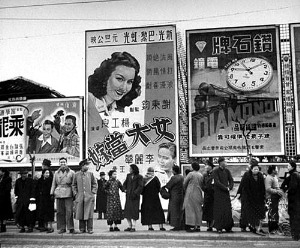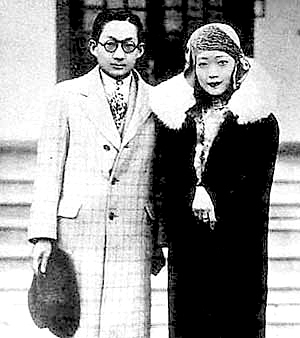 Citizens dressed in "Chinese and Western" costumes can be seen everywhere on the streets.
Citizens dressed in "Chinese and Western" costumes can be seen everywhere on the streets.  Suit Qilu Sun Yat-sen
Suit Qilu Sun Yat-sen  Cheongsam big charming
Cheongsam big charming Dress up, not only for the fashion of China's "fashion" when began? Undoubtedly Xinhai **.
A political feud led to the complete collapse of the feudal dynasty in China and the elimination of the "costume hierarchy" that was stubbornly in the minds of the people for thousands of years. The tradition of “showing the name and distinguishing the prestige†of clothing has become obsolete, and the traditionally harsh concept of ritual and weathering has been completely buried. Change clothing is the pursuit of equal and free life. It is intriguing that the **** of the Xin Hai was not completely thorough, but the clothing of the Xing Hai was rather resolute.
Suits become "** appearance"
To eliminate the old customs, the first is to cut away the symbol of clear political rule, and the second is to no longer wear full-style official clothes. Then, the government formulated the first batch of "regulations".
In July 1912, the Senate announced the service system. The service system divides clothes into three categories: “(1) Western-style dresses, (2) public clothes, (3) regular wears, and dresses are purely imitations of the US system. The public service uses Chinese materials and Western-style clothing. Ancient system, slightly modified, but long and sturdy, in order to boots."
In the upper class, suits become a popular "official wear." From the photographs at the time, we can see the changes in the status of suits on formal occasions. On December 29, 1911, an interim presidential election meeting was held in Nanjing and representatives from 17 provinces took part in the election. There are more than 40 participants, 60% wear robes and 40% wear suits. On February 18, 1912, the second interim presidential election was held. After the meeting, Cai Yuanpei led the Yuan Shikai delegation to Beijing. Of the 11 non-military members in the photo, 8 were in suits. On March 25th of the same year, Premier Tang Shaoyi went to Nanjing to receive the interim government. Sun Yat-sen led the president’s staff to take a photo with Tang Shaoyi. There are more than 40 people on the photo. Only a few people wear traditional clothes and most of them wear suits. Suits have become a must-have for the period.
Foreign dress raises the "national product movement"
The "Conditions and Regulations" boldly introduced Western-style clothes to China. They defined the tuxedo as a large dress, and were equipped with Western-style white shirts, vests, black bow ties, white gloves, and black bowler hats and black patent leather shoes. However, due to the use of imported woolen fabric as the raw material of the dress, it has contributed to the dumping of foreign goods in China, resulting in the unsalable sales of domestic silk and other fabrics. On January 12, 1912, in the “Ta Kung Paoâ€, it was stated in the article “Easy service to preserve domestic goods as the righteousnessâ€: “Easy service is not easy to expect.... The half silk of our people thinks that life is still there. â€
"Declaration" published on May 19, 1912, an article organized by the Hankow Business School in Hankow to maintain the Hankow Domestic Goods Maintenance Association: "Where the participants are, there is no need for foreign clothing and hats as the first obligation." Hankow Save the National Assembly to promote patriotic buying of domestic goods Advocated that there were people who severed their bloodstains, and the scene was very tragic: the Republican Party in Wuhan opened a conference. More than a thousand people attended the meeting. He was accompanied by the county's Cheng Junyu. He spoke on behalf of the county and said that the foreign clothing was sold well in the country. "Please use domestic products", bloody.
The interpretation of the tunic buttons used by the Three Swordsmen is different from that of the tunic. One argument is that Mr. Sun Yat-sen went to Hanoi in Vietnam in 1902 to organise the Sino-Vietnamese meeting, and even entered the western-style clothes shop opened by the Guangdong native Huang Longsheng to save money. And can reflect the Chinese national conditions and teach Italian Huang Longsheng to design a beautiful, simple and practical Chinese clothing. Huang has referenced Western European and Japanese clothing styles, and designed in conjunction with the popular “Business Collar†tops and student outfits of Nanyang’s overseas Chinese at that time. Made of sewn.
When Mr. Zhongshan wears this tunic suit, he said: “This type of clothing is good-looking, practical, convenient, and saves money. Unlike suits, except for tops and shirts, they also need hard collars. These things are mostly imported and costly. At the same time, the tunic was also given the political meaning that no clothing in history has ever had: four pockets, symbolizing the four dimensions of the country, namely, ritual, righteousness, honesty, and shame; five buttons, symbolizing five rights Separate political systems, namely administrative power, legislative power, judicial power, examination power and supervision power. There are three buttons on the cuffs, which represent the ethnic, civil, and people’s lives.
In April 1929, the 22nd State Council resolved the "Regulations on Civilian Uniforms and Dresses": "Uniforms are in tunic suits." In this regard, Zhongshang was officially declared a uniform by the Nationalist Government.
The improved cheongsam was able to catch the button but the "banner bottom" and "horse hoof Sleeve" had disappeared. However, the cheongsam still existed. In the early years, women’s clothing still maintained the shape of the tops and bottoms, and the government also required women’s dresses to be the upper and lower skirts. Influenced by the Western lifestyle, women realized the principle of "curve" and changed the traditional women's wear on the breasts, shoulders, waist and buttocks when they tailored their clothes.
In people's minds, Shanghai at the time should be the “frontier†of fashion. However, in fact, Guangzhou's “West Pass†is a stylish “leader†when it comes to striving for things, and cheongsam is the first to appear in Guangzhou. “Whether it’s an elder wife, er, or a student or housewife, she likes cheongsam.... The cheongsam worn by Xiguan ** is mostly embroidered satin material. The cheongsam is pleated and pleated to highlight the curvaceous beauty of women.†It is the improvement of the traditional cheongsam.
The biggest difference in the improved cheongsam is to boldly draw out the human contour curve. As the robe continues to shrink, the curve of the female figure is finally revealed. "Some of the cheongsam waists were narrow enough to breathe in order to buckle up." In addition, the length of the cheongsam was shortened and the cuffs were also narrowed. The traditional cheongsam is equipped with long trousers. The placket is very shallow and only the embroidered trousers are visible. There are underwear and stockings inside the cheongsam and open legs at the opening.
Hairstyle clothing modern women began to pop According to "The New York Times" records at the time, in addition to Western cosmetics, Chinese women began to spray perfume and even painted lipstick. Hairstyles also began to deviate from tradition. “The ** that the hair on the ladies’ heads was made was no less than that of the men who cut off the lice.†Women began to cut short hair and even began to iron their hair.
At the same time, Chinese women began to wear leather shoes. “Even if they are high-impact high-heeled shoes, they walk easily and quickly and quickly.†“Western-style stockings began to become fashionable. European and American traders are now busy designing new ones. In order to meet the urgent needs of millions of Chinese golden lotus feet."
At the end of the 1920s, underwear was introduced to China from overseas. At that time, people called it "prosperity milk." Initially, Chinese women were not accustomed to using them, and female movie stars became pioneers of fashion experience. Yan Lingyu is one of the earliest Chinese women to wear "prosthetic milk." On the screen, she put on breastmilk and dressed in a cheongsam to show her near-perfect body curve, stunning the women. "Benefiting breastmilk" gradually spread in major cities such as Shanghai and Guangzhou.
- Related links The last Queen's grace: The most fashionable Houyi According to records, photography was introduced to the court at the end of the 19th century. Qi Rong's cheongsam dress photographs are numerous. From the early Qing dynasty female robes to the later popular new cheongsams, there are detailed records. From her photographs, we can sort out the general context in which the cheongsam changes during the Qing Dynasty.
Grace’s early photos showed that her robes and sleeves were both wider and wider. The only difference between the robes and the robes worn by ordinary flag girls was that the materials used were more exquisite and luxurious, and the decorations were more elaborate and meaningful. There are also some cheongsams that are used as daily casual clothes in the photos of Grace. The style is elegant, simple and simple. The length of the kimono for a casual dress is slightly shorter. White socks and embroidered shoes can be seen. Outside the cheongsam, it is also called the "Cloak." The large cymbals are meticulously pleated along the collar, and the edges are scented by the “scented incense sticksâ€.
Grace in the late fashion photos, there are Western-style dress, there is no shortage of cheongsam dresses following the trend, hair changed the early "Dala Wing" and high monotony of the monotony, sometimes shawl hair, sometimes perm, are also followed fashion.
Experts' Comments Accepting New Life Naturally Accepting New Clothes After the Xinhai Revolution, the implementation of new style clothing was an initiative and guidance. It was more gentle and natural than cutting the dumplings, but the effect was more obvious. The author of “The 1911 Revolution†The writer Zhu Yong said, “The change in clothing is actually an expression of people’s inner attitudes. Accepting new ideas, everyone is willing to live in a new way of life and promote the fashion trend better than a “one size fits all†style of government.â€
The word “grade†appears in the feudal society with the highest frequency, and everything in daily life, food and clothing can't be skipped. After the Xinhai Revolution, the imperial power did not exist. The people era began. What kind of clothes became 'private privacy' and no one had the right to interfere.' Zhu Yong said, 'advanced intellectuals who accept Western ideas like to wear suits. But you can't say that Lu Xun, who only wears a long gown in his life, is following the old 'old stubbornness'. Even the word 'mashup' can be traced back to the Xinhai period. “At that time, wearing a pair of leather shoes underneath a gown and a cover suit outside is not a bad idea.†(Reporter Wang Ping)
Anti-Cut/Nitrile Glove,Exam Gloves ,Black Rubber Gloves ,Black Nitrile Gloves
Work & Labor Gloves Co., Ltd. , http://www.nbglove.com